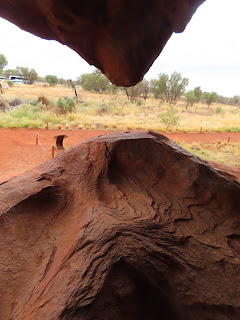As we left the Mala Walk we rounded the Northwest tip where the area was off limits to photography. I sincerely hope that I did not infringe on any of these areas as I watched for the signs and listened to Jack as we were driving. Being on the other side, we found ourselves in the sun which made the color of the rock pop. Perhaps some of the clouds had cleared, but it was nice. We arrived at the trail head to the Kuniya Walk and we strolled in the sun to the waterhole. The Mutitkjulu waterhole is very sacred and the Dalia Llama once came here and meditated with the Original Owners of this land. We heard and saw the scars on the rock from the battle of the python woman and the brown snake man. The waterhole was serene and on the way out I saw a mystery. Jack did not know what it was, nor did the ranger at the visitors center. With a bit more research I am sure that it is a marsupial mole. The recent rains must have chased him aboveground. We saw more rock art, some cool birds and then headed back out. A final stop at the cultural center and a brief picture stop at the sunset viewing center and we were back at the apartment in time for lunch and a nap. 4:30 AM was a very long time ago.
The tall protrusion on the right represent a type of sign post that the people put up to announce a meeting
The figure facing left is of a man thrown into the rocks by an evil spirit and the impact left an imprint of his face
We have rounded the north tip and have arrived at the place where the sand python left her eggs
Now we are at the head of the Kuniya Walk
The sun is out and the rock is orange
A tree up on top!
Off to the waterhole we go
Many of the trees are gum trees, ghost, white and red gum trees
I see a face and a hand on here
The scar from the whack that the python lady gave
So many cool shapes of the rocks
The python lady's head
The gum trees are very white
Nic waterhole
The water flows along this bank
We three trees are thirsty no more
Huge caves
The mystery marsupial mole
I think it is a match
Birds photobombing
Lots of rock art
The original owners are the only ones who know what all these symbols represent
These are most assuredly boomerangs
Big graceful shapes
Kangaroos?
Old swallow nests
A turtle
Black Faced Cuckoo Shrike
Big swallow nests look like a skull
This huge slab has two eyes, a nose and a mouth
The Flaming Falcon was written on the back of this car. Look close and you can see the coat hanger as an antenna









































































